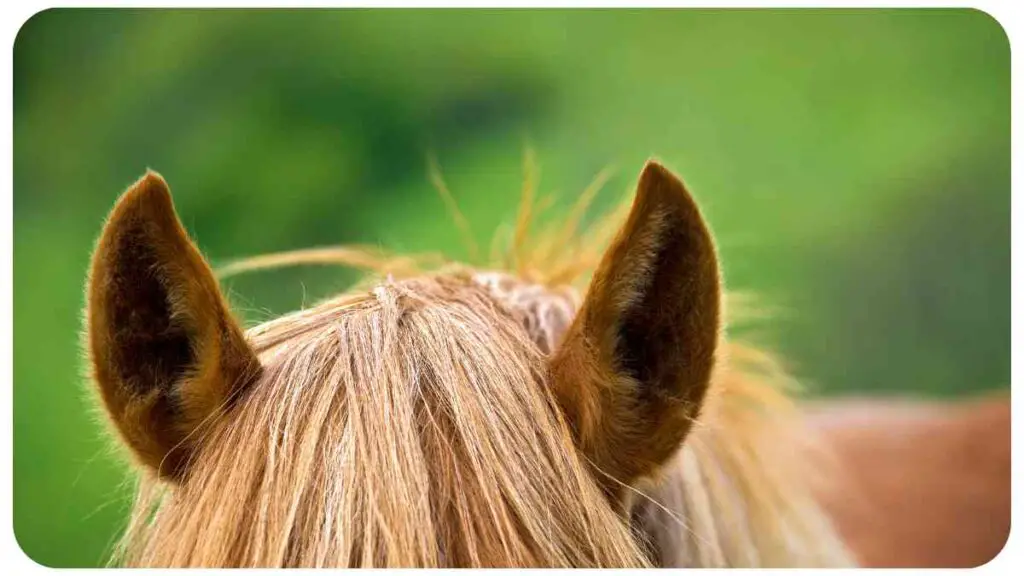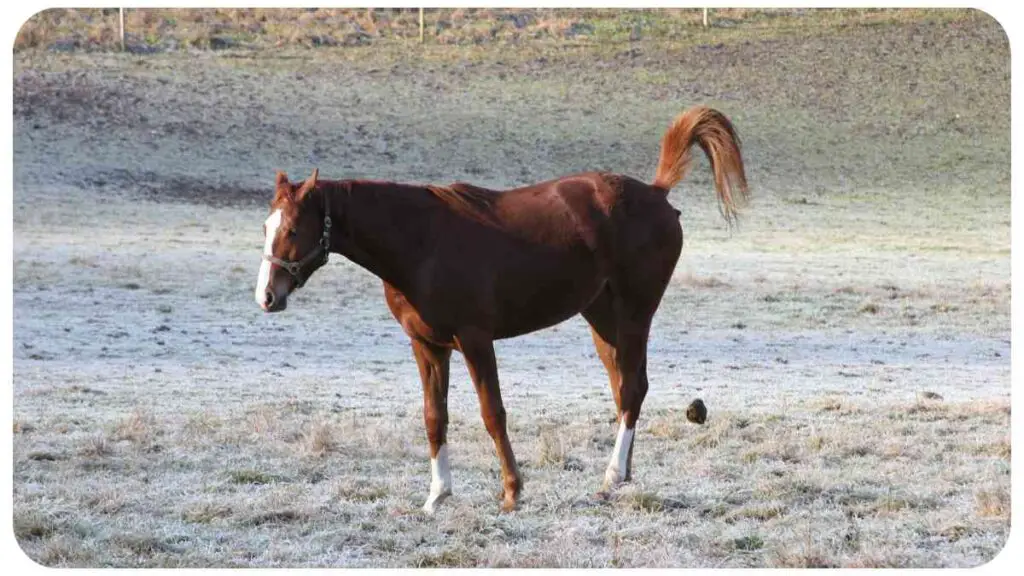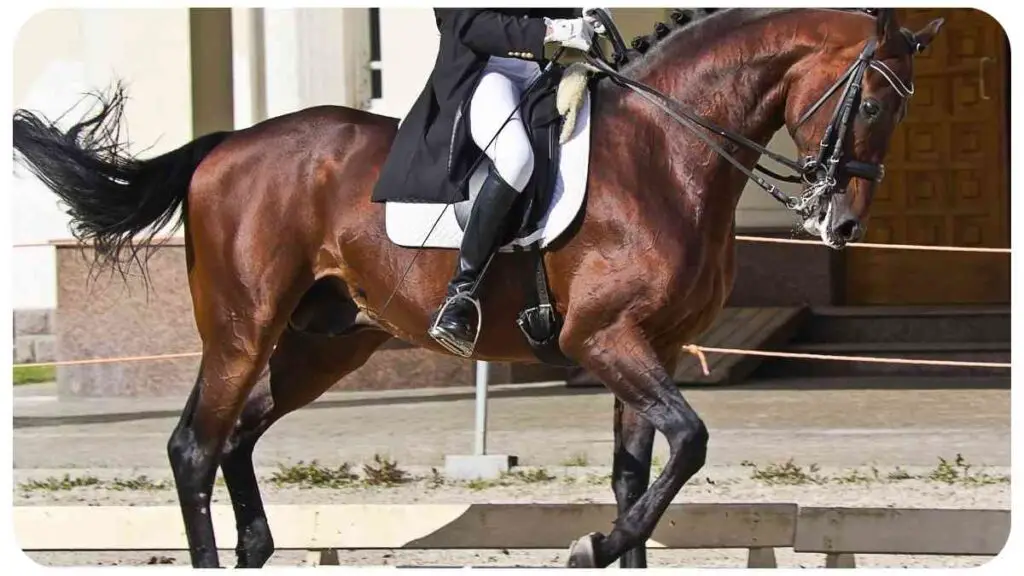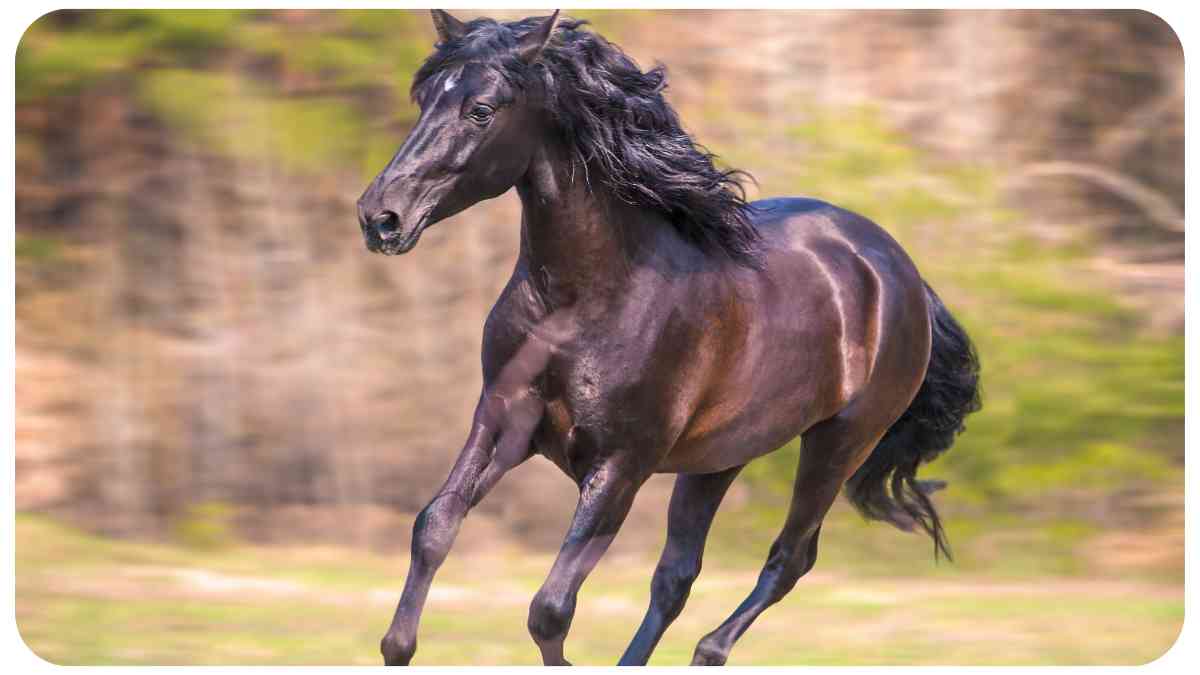Why Understanding Horse Body Language is Crucial
As an experienced equestrian, I cannot stress enough the significance of comprehending horse body language. Horses are incredibly perceptive creatures, and their nonverbal communication is their primary form of expression.
By learning to decode their gestures, postures, and sounds, you can gain profound insights into their emotions, intentions, and overall well-being. This comprehensive guide will equip you with the knowledge and skills to understand and interpret horse body language effectively.
| Takeaways |
|---|
| Understanding horse body language is crucial for effective communication and building a strong bond with horses. |
| Paying attention to ear positions, tail movements, body postures, and vocalizations can provide insights into their emotions and intentions. |
| Building trust and establishing a positive rapport with horses is essential for safe handling and a harmonious partnership. |
| Recognizing abnormal behaviors and addressing underlying issues can help ensure the well-being of your horse. |
| Consistency, patience, and positive reinforcement are key in training and communicating with horses. |
| Further reading and resources can provide in-depth knowledge and enhance your understanding of horse body language and behavior. |
Equine Communication Basics: Decoding Horse Gestures and Signals
Horses have a rich repertoire of gestures and signals that convey their thoughts and feelings. Understanding these basic forms of equine communication is crucial to establish a solid foundation for interpreting their body language accurately. Let’s explore some common horse gestures and their meanings:
| Gesture | Meaning |
| Head tossing | Expressing frustration or discomfort |
| Biting or nipping | Displaying aggression or asserting dominance |
| Pawing the ground | Impatience or anticipation of feeding |
| Sniffing or nuzzling | Displaying curiosity or seeking companionship |
| Stretching neck | Submission or a gesture of non-threatening behavior |
The Language of Ears: What Horse Ear Positions Reveal

A horse’s ears are like windows into their emotions and thoughts. The position and movement of their ears can tell us a lot about how they are feeling at any given moment. Let’s delve into the different horse ear positions and their interpretations:
Understanding horse body language is crucial for every rider, and it’s equally important to be aware of trail riding etiquette during your adventures. By following these guidelines, you can ensure smooth communication with your horse and maintain a harmonious relationship on the trails.
| Ear Position | Interpretation |
| Forward | Alertness or attentiveness |
| Pricked | Heightened focus or curiosity |
| Pinned back | Aggression or assertion of dominance |
| Relaxed and floppy | Contentment or relaxation |
| One forward, one back | Divided attention or uncertainty |
Tales from the Tail: Interpreting Horse Tail Movements

A horse’s tail is like a flag, communicating their emotions and intentions through its various movements. Familiarizing yourself with these tail movements will give you valuable insights into what your horse might be feeling or thinking. Here are some common horse tail movements and their significance:
| Tail Movement | Significance |
| Raised | Heightened alertness or excitement |
| Swishing | Irritation or annoyance |
| Clamped | Nervousness or fear |
| Wagging | Contentment or happiness |
| Tucked | Submission or anxiety |
Eyes Speak Louder than Words: Reading Horse Eye Expressions
The eyes are often regarded as the windows to the soul, and this rings true for horses as well. By observing their eye expressions, we can gain valuable insights into their emotional state. Let’s explore some common horse eye expressions and their implications:
| Eye Expression | Implication |
| Soft and relaxed | Calmness or contentment |
| Wide and alert | Heightened awareness or potential fear |
| Whites showing | Stress, fear, or anxiety |
| Darting glances | Nervousness or uncertainty |
| Half-closed | Relaxation or drowsiness |
To truly understand horse body language, it helps to delve into the history of horseback riding. Exploring how this ancient practice has evolved over time provides valuable context, deepening our appreciation for the ways in which horses communicate and interact with humans.
The Power of Posture: Understanding Horse Body Postures
Horses use their entire bodies to communicate, and their postures can convey a wide range of emotions and intentions. Paying attention to their body language will enhance your understanding of their state of mind. Let’s explore some common horse body postures and their interpretations:
| Body Posture | Interpretation |
| Stiff and tense | Nervousness or fear |
| Relaxed and loose | Contentment or relaxation |
| Raised head | Alertness or attentiveness |
| Back arched | Defensive or asserting dominance |
| Head lowered | Submission or relaxation |
Vocalizing Feelings: Deciphering Horse Sounds and Vocalizations
Horses have a range of sounds and vocalizations they use to communicate with each other and with us. Understanding what these vocalizations mean can help you gauge their emotions and intentions. Here are some common horse sounds and their meanings:
| Sound | Meaning |
| Neighing | Greeting or seeking attention |
| Whinny | Calling out to other horses or expressing excitement |
| Snorting | Displaying alertness or surprise |
| Screaming or squealing | Distress, fear, or pain |
| Nicker | Displaying affection or anticipation |
Equine Social Interactions: Unraveling Horse Herd Dynamics
Horses are social animals that live in herds, and their interaction with other horses reveals a lot about their behavior and dynamics. By understanding their herd behavior, you can gain insights into their individual actions and reactions. Let’s explore some aspects of horse herd behavior and their significance:
When it comes to horseback riding, prioritizing safety is paramount. This includes mastering proper riding techniques that enhance communication with your horse, ensuring a safer and more successful equestrian experience for both rider and equine partner
| Herd Behavior | Significance |
| Agonistic interactions | Establishing hierarchy and social order |
| Mutual grooming | Building social bonds and displaying affection |
| Playful chasing | Strengthening social connections and releasing energy |
| Herd formation | Promoting safety and security within the group |
| Separation anxiety | Experiencing stress when isolated from the herd |
Unusual Horse Behavior: Signs of Discomfort or Distress
It’s essential to be aware of any unusual behavior exhibited by horses, as it can indicate discomfort or distress. By recognizing these signs early on, you can address the underlying issue and ensure the well-being of your horse. Let’s explore some common abnormal horse behaviors and possible causes:
| Behavior | Possible Causes |
| Excessive pawing | Anxiety, pain, or frustration |
| Circling or weaving | Boredom, stress, or confinement |
| Head pressing | Neurological issues or pain |
| Kicking or biting | Aggression, frustration, or pain |
| Excessive rolling | Skin irritation or physical discomfort |
Horse and Rider: Communication in the Saddle

Effective communication between horse and rider is crucial for a harmonious partnership. Beyond understanding their body language on the ground, it’s essential to recognize the cues and responses while riding. Here are some horse-rider communication cues and their corresponding responses:
Maintaining well-being entails paying attention to all aspects of horse care, including hoof care. By keeping your horse’s feet in top shape, you promote overall health and soundness, enabling them to communicate effectively through body language without physical discomfort or issues
| Communication Cue | Horse Response |
| Light leg pressure | Moving forward or increasing speed |
| Rein contact | Slowing down or stopping |
| Body weight shift | Changing direction or turning |
| Slight squeeze | Transitions or changes in gait |
| Voice command | Acknowledging or responding to the command |
Safety Considerations: Establishing Trust and Handling Horses Safely
When working with horses, safety should always be a top priority. Building trust and handling them properly is essential to maintain a positive and safe environment. Let’s explore some important safety guidelines for handling horses:
| Safety Guideline | Description |
| Approach from the front | Approaching from the front allows the horse to see you |
| Use a confident yet calm demeanor | Showing confidence while remaining calm |
| Avoid sudden movements | Sudden movements can startle or agitate the horse |
| Wear appropriate footwear | Sturdy closed-toe shoes with a low heel for protection |
| Maintain a safe distance | Give the horse ample personal space to avoid accidents |
Building a Connection: Developing a Rapport with Horses
To truly understand and communicate with horses, developing a connection and rapport is essential. By building trust and mutual respect, you can establish a strong bond with your equine companion. Here are some techniques for building trust with horses:
| Trust-building Technique | Description |
| Spend quality time together | Devote time to interact and engage with your horse |
| Practice gentle grooming | Establish a positive association through grooming |
| Use reward-based training | Encourage desired behaviors with positive reinforcement |
| Be consistent and reliable | Maintain a dependable and predictable routine |
| Listen and respond to cues | Pay attention to your horse’s signals and respond accordingly |
Training Methods: Using Body Language to Teach and Communicate
Horses are highly responsive to body language, making it an effective tool for training and communication. By utilizing your own body language effectively, you can convey cues and commands clearly to your horse. Here are some training techniques using body language:
Horses communicate primarily through non-verbal signals, and comprehending these subtle cues is key to understanding their needs. By learning about your horse’s silent signals, you can establish a deeper connection and respond appropriately, fostering trust and mutual understanding between horse and rider.
| Training Technique | Description |
| Clear posture and position | Use your body to communicate direction and intention |
| Reinforce with voice commands | Pair body language cues with verbal cues for clarity |
| Timing and release of cues | Provide cues at the right moment and release pressure |
| Use positive reinforcement | Reward desired behaviors to encourage repetition |
| Practice consistency | Ensure consistency in your body language and cues |
Horse Behavior Problems: Causes, Prevention, and Solutions
Understanding common horse behavior problems can help you identify their causes, take preventive measures, and implement effective solutions. Let’s explore some common horse behavior problems and potential remedies:
| Behavior Problem | Possible Causes | Solutions |
| Biting or kicking | Aggression, fear, or discomfort | Address underlying causes, proper training |
| Barn sour or herd bound | Separation anxiety or reliance on herd | Gradual desensitization, training exercises |
| Nervousness or spooking | Environmental triggers or lack of confidence | Desensitization, building trust and confidence |
| Refusing jumps | Fear, physical discomfort, or lack of training | Address underlying issues, progressive training |
| Trailer loading difficulties | Fear, lack of experience, or past negative experiences | Patient training, positive reinforcement |
Conclusion: Enhancing Your Relationship with Horses
Understanding horse body language is the key to building a strong bond and effective communication with these magnificent creatures. By decoding their gestures, postures, sounds, and expressions, you can develop a deep understanding of their emotions, intentions, and needs. Remember to approach horses with respect, patience, and kindness, always prioritizing their safety and well-being. May your journey with horses be filled with joy, connection, and a mutual understanding.
This concludes our comprehensive guide to understanding horse body language. May you now embark on a fulfilling journey of equine communication and strengthen your relationship with these incredible animals. Happy trails!
Further Reading
If you’re eager to delve deeper into the topic of horse body language and communication, here are some recommended resources:
- Equus Magazine: Horse Body Language
- Provides an insightful article on interpreting horse body language, covering various gestures, postures, and vocalizations.
- Equine Helper: How Horses Communicate
- Explores the different ways horses communicate and interact with each other, highlighting their body language and vocalizations.
- Horse Behaviour: Interpreting Body Language and Communication
- Offers a comprehensive book that delves into the complexities of horse behavior, focusing on body language interpretation and communication.
FAQs
How can I tell if a horse is relaxed or stressed?
Observing their body posture, ear positions, and tail movements can help distinguish between relaxation and stress. Relaxed horses often have loose muscles, lowered heads, and floppy ears, while stressed horses may exhibit tense postures, raised heads, and tail swishing.
What does it mean if a horse shows its teeth?
When a horse shows its teeth, it can indicate aggression or dominance. Baring teeth, accompanied by a threatening posture or biting gestures, may signify a warning or an assertion of dominance.
How can I build trust with a horse?
Building trust with a horse requires patience, consistency, and positive reinforcement. Spending quality time together, offering gentle grooming, and using reward-based training techniques can foster trust and strengthen the bond between horse and handler.
Why is it important to understand horse herd behavior?
Understanding horse herd behavior is crucial because domesticated horses still retain their natural instincts from living in herds. By recognizing their social dynamics and behaviors, you can better understand how horses interact with each other and interpret their actions and reactions.
How should I handle a horse that refuses to load in a trailer?
Dealing with trailer loading difficulties requires patience and positive training techniques. Gradual desensitization, using pressure-release cues, and rewarding small steps of progress can help overcome a horse’s fear or resistance associated with loading in a trailer. Seeking professional guidance may be beneficial in challenging situations.

Hi there! My name is Hellen James, and I’m a horse riding expert. I’ve been riding horses since I was just a kid—and it’s been my passion ever since. But getting started with horse riding can be overwhelming. There’s so much to learn! If you’re looking for a way to get started and make sure you’re doing it right, I’m here to help.


